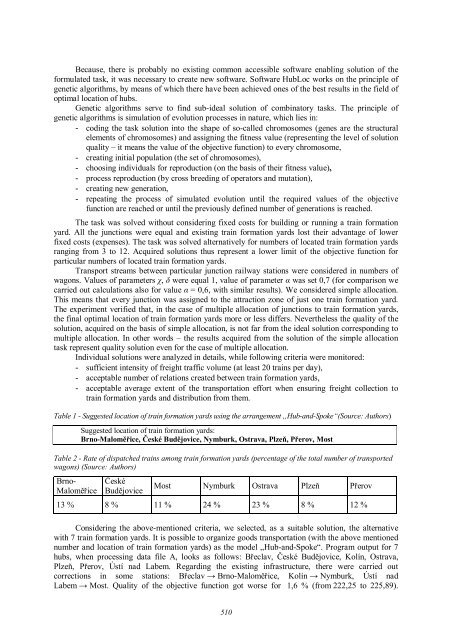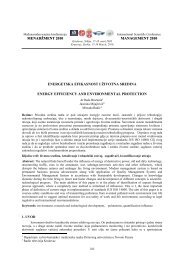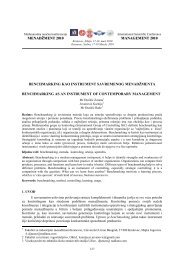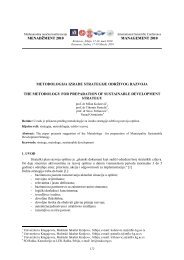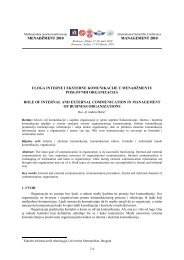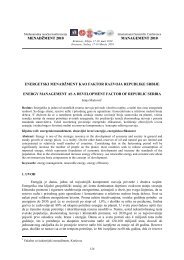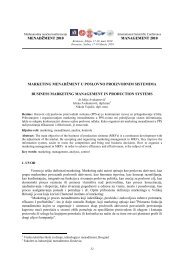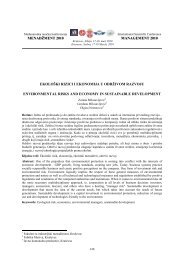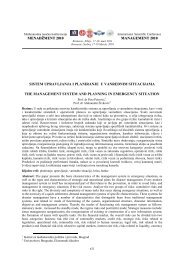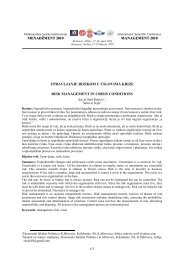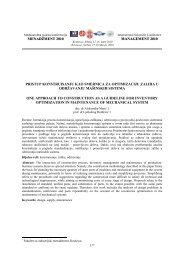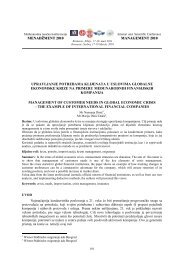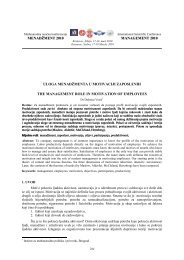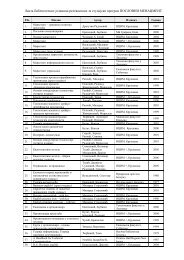intermodal transportation of iso containers and its implementation to ...
intermodal transportation of iso containers and its implementation to ...
intermodal transportation of iso containers and its implementation to ...
You also want an ePaper? Increase the reach of your titles
YUMPU automatically turns print PDFs into web optimized ePapers that Google loves.
Because, there is probably no existing common accessible s<strong>of</strong>tware enabling solution <strong>of</strong> the<br />
formulated task, it was necessary <strong>to</strong> create new s<strong>of</strong>tware. S<strong>of</strong>tware HubLoc works on the principle <strong>of</strong><br />
genetic algorithms, by means <strong>of</strong> which there have been achieved ones <strong>of</strong> the best results in the field <strong>of</strong><br />
optimal location <strong>of</strong> hubs.<br />
Genetic algorithms serve <strong>to</strong> find sub-ideal solution <strong>of</strong> combina<strong>to</strong>ry tasks. The principle <strong>of</strong><br />
genetic algorithms is simulation <strong>of</strong> evolution processes in nature, which lies in:<br />
- coding the task solution in<strong>to</strong> the shape <strong>of</strong> so-called chromosomes (genes are the structural<br />
elements <strong>of</strong> chromosomes) <strong>and</strong> assigning the fitness value (representing the level <strong>of</strong> solution<br />
quality – it means the value <strong>of</strong> the objective function) <strong>to</strong> every chromosome,<br />
- creating initial population (the set <strong>of</strong> chromosomes),<br />
- choosing individuals for reproduction (on the basis <strong>of</strong> their fitness value),<br />
- process reproduction (by cross breeding <strong>of</strong> opera<strong>to</strong>rs <strong>and</strong> mutation),<br />
- creating new generation,<br />
- repeating the process <strong>of</strong> simulated evolution until the required values <strong>of</strong> the objective<br />
function are reached or until the previously defined number <strong>of</strong> generations is reached.<br />
The task was solved without considering fixed costs for building or running a train formation<br />
yard. All the junctions were equal <strong>and</strong> existing train formation yards lost their advantage <strong>of</strong> lower<br />
fixed costs (expenses). The task was solved alternatively for numbers <strong>of</strong> located train formation yards<br />
ranging from 3 <strong>to</strong> 12. Acquired solutions thus represent a lower limit <strong>of</strong> the objective function for<br />
particular numbers <strong>of</strong> located train formation yards.<br />
Transport streams between particular junction railway stations were considered in numbers <strong>of</strong><br />
wagons. Values <strong>of</strong> parameters χ, δ were equal 1, value <strong>of</strong> parameter α was set 0,7 (for compar<strong>iso</strong>n we<br />
carried out calculations also for value α = 0,6, with similar results). We considered simple allocation.<br />
This means that every junction was assigned <strong>to</strong> the attraction zone <strong>of</strong> just one train formation yard.<br />
The experiment verified that, in the case <strong>of</strong> multiple allocation <strong>of</strong> junctions <strong>to</strong> train formation yards,<br />
the final optimal location <strong>of</strong> train formation yards more or less differs. Nevertheless the quality <strong>of</strong> the<br />
solution, acquired on the basis <strong>of</strong> simple allocation, is not far from the ideal solution corresponding <strong>to</strong><br />
multiple allocation. In other words – the results acquired from the solution <strong>of</strong> the simple allocation<br />
task represent quality solution even for the case <strong>of</strong> multiple allocation.<br />
Individual solutions were analyzed in details, while following criteria were moni<strong>to</strong>red:<br />
- sufficient intensity <strong>of</strong> freight traffic volume (at least 20 trains per day),<br />
- acceptable number <strong>of</strong> relations created between train formation yards,<br />
- acceptable average extent <strong>of</strong> the <strong>transportation</strong> effort when ensuring freight collection <strong>to</strong><br />
train formation yards <strong>and</strong> distribution from them.<br />
Table 1 - Suggested location <strong>of</strong> train formation yards using the arrangement „Hub-<strong>and</strong>-Spoke“(Source: Authors)<br />
Suggested location <strong>of</strong> train formation yards:<br />
Brno-Maloměřice, České Budějovice, Nymburk, Ostrava, Plzeň, Přerov, Most<br />
Table 2 - Rate <strong>of</strong> dispatched trains among train formation yards (percentage <strong>of</strong> the <strong>to</strong>tal number <strong>of</strong> transported<br />
wagons) (Source: Authors)<br />
Brno-<br />
Maloměřice<br />
České<br />
Budějovice<br />
Most Nymburk Ostrava Plzeň Přerov<br />
13 % 8 % 11 % 24 % 23 % 8 % 12 %<br />
Considering the above-mentioned criteria, we selected, as a suitable solution, the alternative<br />
with 7 train formation yards. It is possible <strong>to</strong> organize goods <strong>transportation</strong> (with the above mentioned<br />
number <strong>and</strong> location <strong>of</strong> train formation yards) as the model „Hub-<strong>and</strong>-Spoke“. Program output for 7<br />
hubs, when processing data file A, looks as follows: Břeclav, České Budějovice, Kolín, Ostrava,<br />
Plzeň, Přerov, Ústí nad Labem. Regarding the existing infrastructure, there were carried out<br />
corrections in some stations: Břeclav → Brno-Maloměřice, Kolín → Nymburk, Ústí nad<br />
Labem → Most. Quality <strong>of</strong> the objective function got worse for 1,6 % (from 222,25 <strong>to</strong> 225,89).<br />
510


